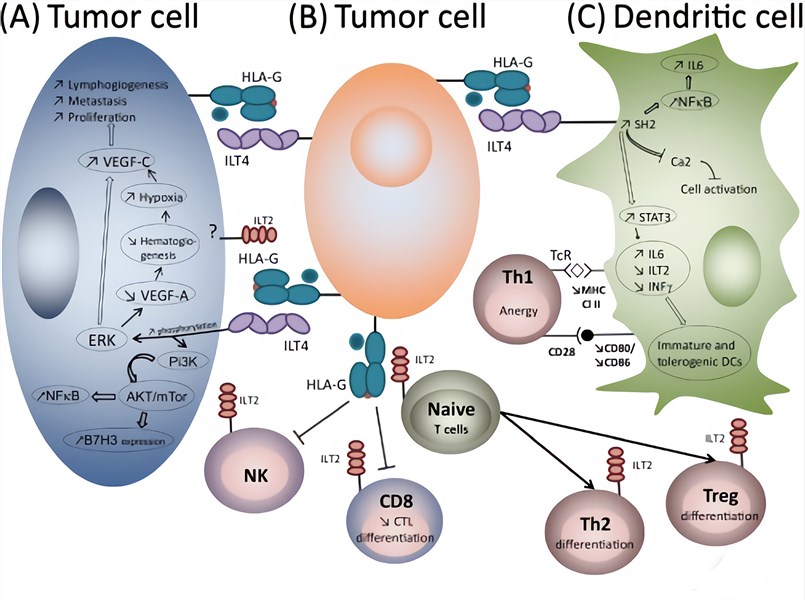Molecules of the human leukocyte immunoglobulin-like receptor (LILR) family are expressed on leukocytes and are commonly dysregulated in a wide range of pathologies. There are 5 activating (LILRA1, 2, 4-6), 5 inhibitory (LILRB1-5), and 1 soluble (LILRA3) LILR that together regulate immune responses. They display 2, or 4, homologous C-2-type Ig-like extracellular domains but differ in their transmembrane and cytoplasmic regions.
Table.1 LILR family member.
| Principle Name | CD Name | Alternative Names | Expression |
| LILRA1 | CD85i | LIR-6, LIR6 | Macrophages |
| LILRA2 | CD85h | ILT1, LIR-7, LIR7 | Monocytes, macrophages, dendritic cells, NK cells, basophils, eosinophils |
| LILRA3 | CD85e | ILT6, LIR-4, LIR4, HM43, HM31 | Monocytes |
| LILRA4 | CD85g | ILT7 | Plasmacytoid dendritic cells |
| LILRA5 | CD85f | ILT11, LIR-9, LIR9, LILRB7 | CD14+ monocytes |
| LILRA6 | CD85b | ILT8, LILRB6 | Unknown |
| LILRB1 | CD85j | ILT2, LIR-1, LIR1, MIR7 | Monocytes, macrophages, dendritic cells, osteoclasts, eosinophils, B cells, T cells, NK cells, placental stromal cells |
| LILRB2 | CD85d | ILT4, LIR-2, LIR2, MIR10, MIR-10 | Monocytes, macrophages, dendritic cells, osteoclasts, basophils, eosinophils, placental vascular smooth muscle |
| LILRB3 | CD85a | ILT5, LIR-3, LIR3, HL9 | Monocytes, macrophages, dendritic cells, osteoclasts, basophils, eosinophils |
| LILRB4 | CD85k | ILT3, LIR-5, LIR5, HM18 | Monocytes, macrophages, dendritic cells, osteoclasts |
| LILRB5 | CD85c | LIR-8, LIR8 | Unknown |
Specifically, LILRA has short truncated cytoplasmic tails with charged arginine residues in their transmembrane domains, facilitating association with the immunoreceptor tyrosine-based activation motif-bearing Fcε receptor γ chain to propagate activating signaling cascades. Conversely, LILRB has long cytoplasmic tails containing multiple immunoreceptor tyrosine-based inhibition motifs (ITIMs), which recruit phosphatases such as SHP-1 and SHIP-1 to elicit inhibitory signaling.
 Fig.1. The LILR family.1,2
Fig.1. The LILR family.1,2
The LILRB molecules are proposed to act as immune checkpoints serving to control and limit overt immune responses. LILRB expression is increased in suppressive macrophages and tolerogenic dendritic cells. On monocytes, colligation of LILRB1 and LILRB2 with the activatory Fcγ receptor I results in SHP-1 activation, decreasing downstream phosphorylation events and intracellular calcium mobilization. Engagement of LILRB1 on macrophages by the common HLA-I subunit, β2-microglobulin, on malignant cells limits their phagocytic potential. It has also been proved that ligation of LILRB1, 2, or 4 renders DCs tolerogenic, leading to inhibition of T cell responses. The engagement of LILRB1 and LILRB2 by their high-affinity ligand HLA-G is an important immunosuppressive pathway at the fetal-maternal interface during pregnancy and may be involved in tumor immune evasion.
 Fig.2 HLA-G-induced pathways following interaction with its receptors. (Carosella, 2021)
Fig.2 HLA-G-induced pathways following interaction with its receptors. (Carosella, 2021)
LILRB1 and LILRB2 are immune checkpoint receptors that regulate a wide range of physiological responses by binding to diverse ligands, exerting their functions in immunological, neurologic, developmental, and infectious responses. Fig.2 shows the interaction between HLA-G and LILRB1/LILRB2 receptors. Recent findings also reveal powerful immunosuppressive functions of LILRB3 and identify it as an important myeloid checkpoint receptor. Currently, many antibodies targeting human LILRBs are under clinical trials.
Many types of research and development programs target the LILRA/B of myeloid checkpoints to overcome immune resistance. Creative Biolabs brings significant drug discovery and development expertise to this challenge, complementary to over a decade of research by academic collaborators, to evaluate the role of this family of receptors in cancer. Our highlighted immune checkpoint-related services include immune checkpoint assays, immune checkpoint antibody development, and so on. For more services, please refer to our Services for more information. Please don't hesitate to contact us for more details.
Reference
All listed customized services & products are for research use only, not intended for pharmaceutical, diagnostic, therapeutic, or any in vivo human use.
USA
Tel:
Fax:
Email:
Copyright © 2025 Creative Biolabs. All Rights Reserved.